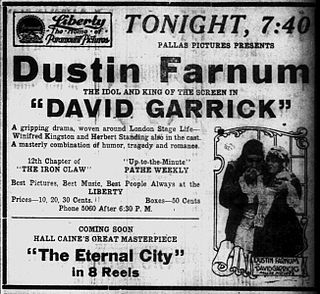Related Research Articles

Henri-Léon-Gustave-Charles Bernstein was a French playwright associated with Boulevard theatre.

The Scandal is a 1934 French romantic drama film directed by Marcel L'Herbier and starring Gaby Morlay, Henri Rollan, and Jean Galland. The film is based on a play written by Henry Bataille, which had previously been turned in a 1923 British silent film of the same title.

A Tale of Two Cities is a 1917 American silent historical drama film directed by Frank Lloyd and starring William Farnum, Jewel Carmen, and Charles Clary. The film is based on Charles Dickens' 1859 novel of the same name, which has been filmed a number of times.

David Garrick is a 1916 American silent historical film directed by Frank Lloyd and starring Dustin Farnum, Winifred Kingston and Herbert Standing. The film was based on Thomas William Robertson's 1864 play of the same name, which portrayed the life of the eighteenth century British actor David Garrick. It was one of several film versions of the play made during the silent era.

Sowing the Wind is a 1944 French drama film directed by Maurice Gleize and starring Jacques Dumesnil, Marcelle Géniat and Lise Delamare. It is an adaptation of the 1925 novel of the same title by Lucie Delarue-Mardrus The film's sets were designed by the art director Robert-Jules Garnier.

Samson is 1936 French drama film directed by Maurice Tourneur and starring Harry Baur, Gaby Morlay and André Lefaur. It was based on the 1908 play of the same title by Henri Bernstein, which had previously been made into three silent films. The film was shot at the Joinville Studios in Paris, with sets designed by the art director Guy de Gastyne.

Shackles of Gold is a 1922 American silent drama film directed by Herbert Brenon and starring William Farnum, Alfred Loring, and Marie Shotwell. It is an adaptation of the 1908 play Samson by Henri Bernstein with the setting moved from France to America. The screenplay involves a woman from an aristocratic but poor family who is pressured by her relatives to marry a wealthy financier.

Samson is a 1915 American silent drama film directed by Edgar Lewis and starring William Farnum, Maude Gilbert and Edgar L. Davenport. It is an adaptation of Henri Bernstein's play Samson. Farnum later appeared in a second adaptation Shackles of Gold, although the setting was switched from France to America.
Samson (Italian:Sansone) is a 1923 Italian silent drama film directed by Torello Rolli and starring Angelo Ferrari and Elena Sangro. It is an adaptation of the 1908 play of the same title by Henri Bernstein. A woman from a poor aristocratic family is pressured by her relatives to marry a wealthy businessman, although she doesn't love him.
Odette is a 1934 Italian drama film based upon the play by Victorien Sardou, directed by Jacques Houssin and Giorgio Zambon and starring Francesca Bertini, Samson Fainsilber, Jacques Maury. Bertini had appeared in two previous versions of the story, the first a 1916 silent film Odette.

Playing with Souls is a 1925 American silent drama film directed by Ralph Ince and starring Jacqueline Logan, Mary Astor, and Clive Brook.

The Marriage of Mademoiselle Beulemans is a 1927 French silent comedy film directed by Julien Duvivier and starring Andrée Brabant, Jean Dehelly and Gustave Libeau. It is based on the 1910 Belgian play Le Mariage de mademoiselle Beulemans.
Gemma De Ferrari was an Italian film actress of the silent era.

Your Friend and Mine is a 1923 American silent drama film directed by Clarence G. Badger and starring Enid Bennett, Huntley Gordon, and Willard Mack. It is based upon the play of the same name by Mack.

The Gay Lord Quex is a lost 1919 American silent comedy film directed by Harry Beaumont and starring Tom Moore, Gloria Hope, and Naomi Childers It is based on the 1899 play The Gay Lord Quex by the British writer Arthur Wing Pinero.
Kean, ou Désordre et génie is an 1836 play by the French writer Alexandre Dumas.

Daughters of the Rich is a 1923 American silent drama film directed by Louis J. Gasnier and starring Miriam Cooper, Gaston Glass, and Ethel Shannon based upon the 1900 novel of the same name by Edgar Saltus.

The French Doll is a 1923 American silent comedy drama film directed by Robert Z. Leonard and starring Mae Murray, Orville Caldwell and Rod La Rocque. It was based on a French-language novel by Paul Armont and Marcel Gerbidon.
Jean Joffre (1872–1944) often styled simply as Joffre was a French film and stage actor. A character actor he played a variety of supporting roles in theatre and the cinema during his career. His final screen appearance was in the 1943 film The Count of Monte Cristo.

Lights Out is a 1923 American silent crime drama film directed by Alfred Santell and starring Ruth Stonehouse, Walter McGrail and Theodore von Eltz. It is based on the 1922 play Lights Out by Paul Dickey and Mann Page, later adapted into the 1938 film Crashing Hollywood. The remake was more light-hearted than the melodramatic tone of the original.
References
- ↑ Goble p.38